load capacity AUDI A7 2012 Owners Manual
[x] Cancel search | Manufacturer: AUDI, Model Year: 2012, Model line: A7, Model: AUDI A7 2012Pages: 294, PDF Size: 73.33 MB
Page 60 of 294
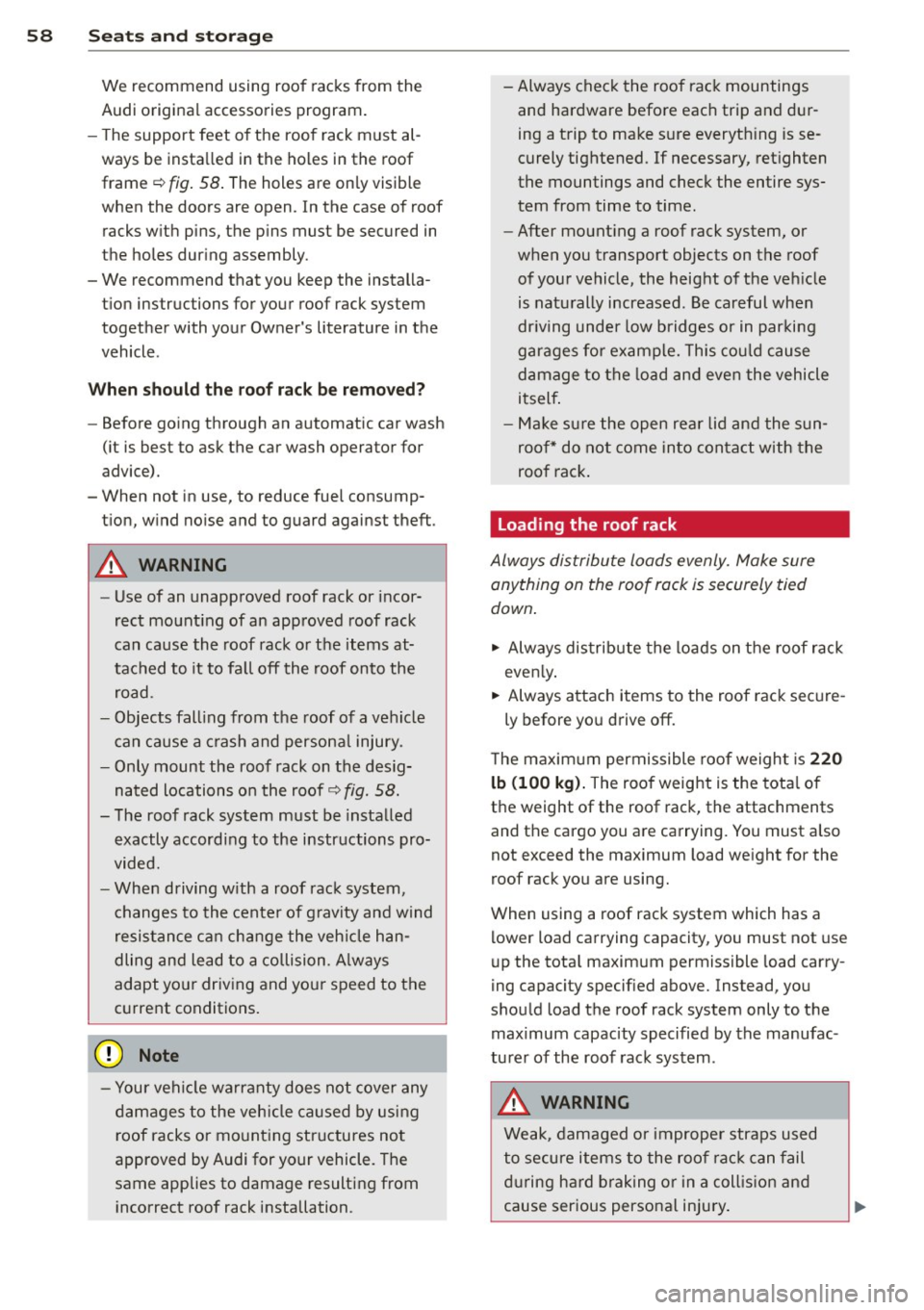
58 Seat s a nd s tor ag e
We recommend using roof racks from the
Audi original accessories program.
- T he support feet of the roof rack must al
ways be insta lled in the holes in the roof
frame ~
fig. 58 . The holes are only visible
when the doors are open . In the case of roof
racks with pins, the pins must be secured in
the holes during assembly.
- We recommend that you keep the installa
tion instructions for your roof rack system
together with your Owner's literature in the
vehicle.
Wh en sh ould the roo f ra ck be re mo ved ?
-Before going through an automatic car wash
(it is best to ask the car wash operator for
advice).
- When not in use, to reduce fuel consump
tion, wind no ise and to guard against theft.
A WARNING
-Use of an unapproved roof rack or incor
rect mount ing of an approved roof rack
can cause the roof rack o r the items at
tached to it to fa ll off the roof onto the
road.
- Objects fall ing from the roof of a vehicle
can cause a crash and persona l injury.
- Only mount the roof rack on the desig
nated locations o n the roof ~
fig. 58.
-The roof rack system must be installed
exactly according to the instructions pro
vided.
- When driving w ith a roof rack system,
changes to the center of g ravity and wind
resistance ca n cha nge the veh icle han
dling and lead to a collision. A lways
adapt yo ur driv ing and you r speed to the
c u rrent conditions.
(D Note
- Your vehi cle warranty does not cover any
damages to the veh icle caused by using
r oof racks or mo unt ing structures not
approved by Audi for your vehicle. The
same applies to damage resulting from
i ncorrect roof rack installation. - Always check the roof rack mountings
and hardware before each trip and dur
ing a trip to make s ure everyth ing is se
curely tightened.
If necessary, ret ighten
the mountings and check the entire sys
tem from time to time.
- After mounting a roof rack system, or
when you transport objects on the roof
of your vehicle, the height of the veh icle
is naturally increased. Be careful when
dr iving unde r low bridges or in parking
garages for example. This cou ld cause
damage to the load and even the vehicle
itself .
- Ma ke sure the open rear lid and the sun
roo f* do not come into contact with the
roo f rack .
Loading the roof rack
Always distribute loads evenly. Make sure
anything on the roof rack is securely tied
down .
.,. Always distrib ute the loads on the roof rack
even ly .
.,. Always attach items to the roof rack secure-
ly before you drive off.
T he maxim um permissible roof weight is
220
lb (100 kg ).
The roof weig ht is the tota l of
the weight of the roof rack, the attachments
and the cargo you are carrying. You must a lso
not exceed the maximum load weight for the
roof rack you are using.
When using a roof rack system which has a
l ower load carrying capacity, you must not use
up the total maxim um permissible load carry
ing capacity specif ied above. Instead, you
shou ld load the roof rack system only to the
maximum capacity specified by the manufac
tu rer of the roof rack system .
A WARNING
Weak, damaged o r improper straps used
to secure items to the roof ra ck can fail
d uring h ard braking or in a coll is ion and
cause serious personal inju ry .
.
Page 61 of 294
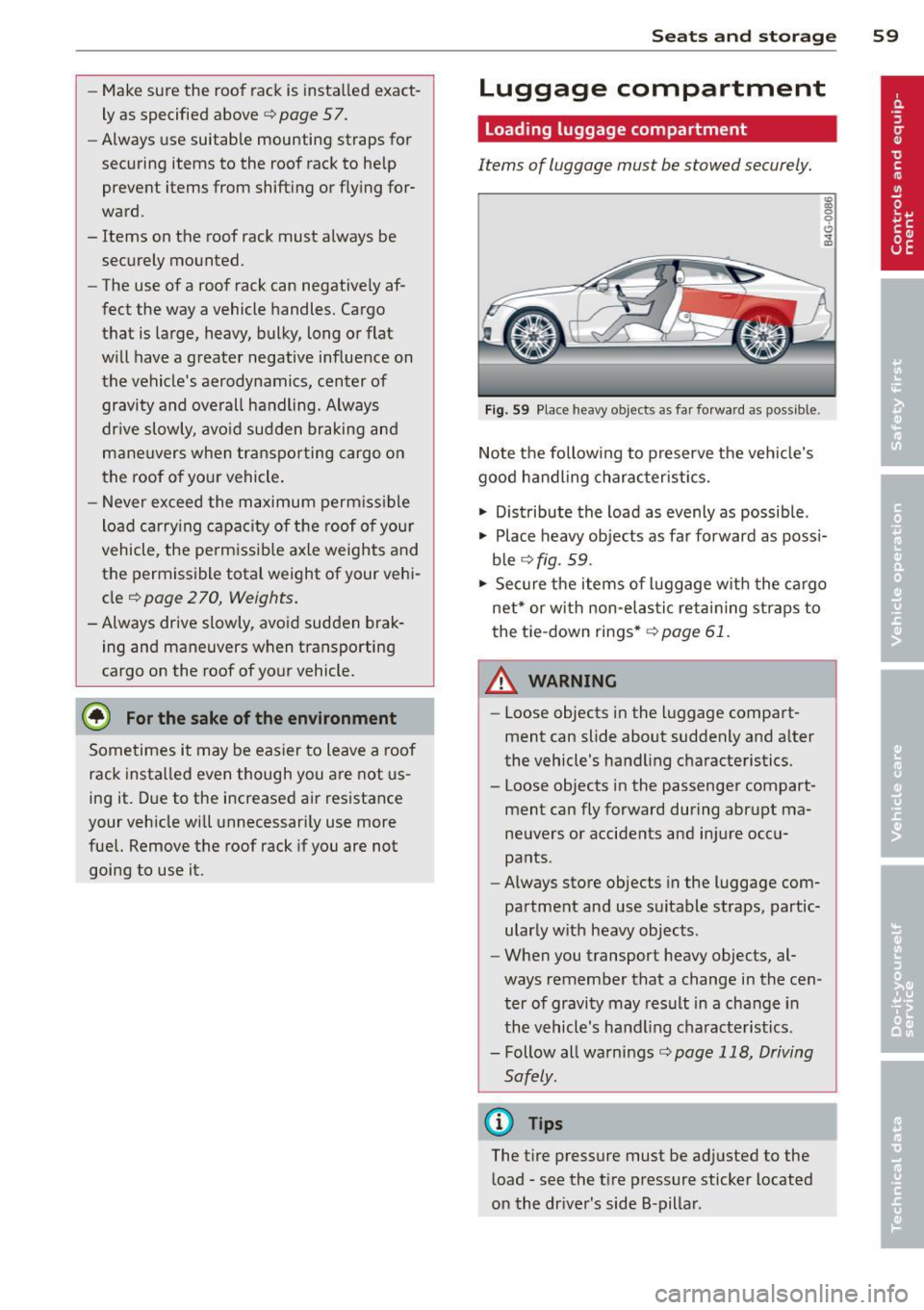
-Make sure the roof rack is instal led exact
ly as specified above
c::> page 57.
- Always use suitable mounting straps for
securing items to the roof rack to help
prevent items from shifting or flying for
ward.
- Items on the roof rack must always be securely mounted.
- The use of a roof rack can negative ly af
fect the way a vehicle handles. Cargo
that is large, heavy, bulky, long or flat
will have a greater negative influence on
the vehicle's aerodynamics, center of
gravity and overall handling. Always dr ive slowly, avo id sudden braking and
maneuvers when transpo rting cargo on
the roof o f your vehicle .
- Never exceed the maximum perm iss ible
load carry ing capacity of t he roof of your
vehicle, the perm issib le axle weights and
the permissible total weight of your vehi cle
c::> page 270 , Weights.
- Always drive slowly, avoid sudden brak
ing and maneuvers when transporting
cargo on the roof of your vehicle.
@ For the sake of the environment
Sometimes it may be easier to leave a roof
rack insta lled even though you are not us
ing it. Due to the increased air resistance
your vehicle will unnecessari ly use more
fuel. Remove the roof rack if you are not going to use it.
Sea ts a nd s to rage 59
Luggage compartment
Loading luggage compartment
Items of luggage must be stowed securely.
Fig. 59 Place heavy objects as far forward as possible.
Note the following to preserve the vehicle's
good handling charac teristics.
.., Distribute the load as evenly as possible .
.., Place heavy objects as far forward as poss i
ble
c::> fig. 59.
.., Secure the items of luggage w ith the cargo
net* or w ith non -elastic retaining straps to
the tie-down rings *
c::> page 61.
A WARNING
-Loose objects in the l uggage compart
ment can slide about suddenly and a lter
the vehicle's handling characteristics.
- Loose objects in the passenger compart
ment can fly forward during abr upt ma
neuvers or accidents and injure occu
pants .
- Always store objects in the luggage com
partment and use suitable straps, partic
ularly with heavy objects.
-
- When you transport heavy objects, al
ways remember that a change in the cen
ter of gravity may result in a change in
the vehicle's handling characteristics.
- Follow all warnings
c::> page 118, Driving
Safely.
(D Tips
The t ire pressure must be ad justed to the
load -see the t ire pressure sticker located
on the dr iver's side B-pillar .
Page 127 of 294
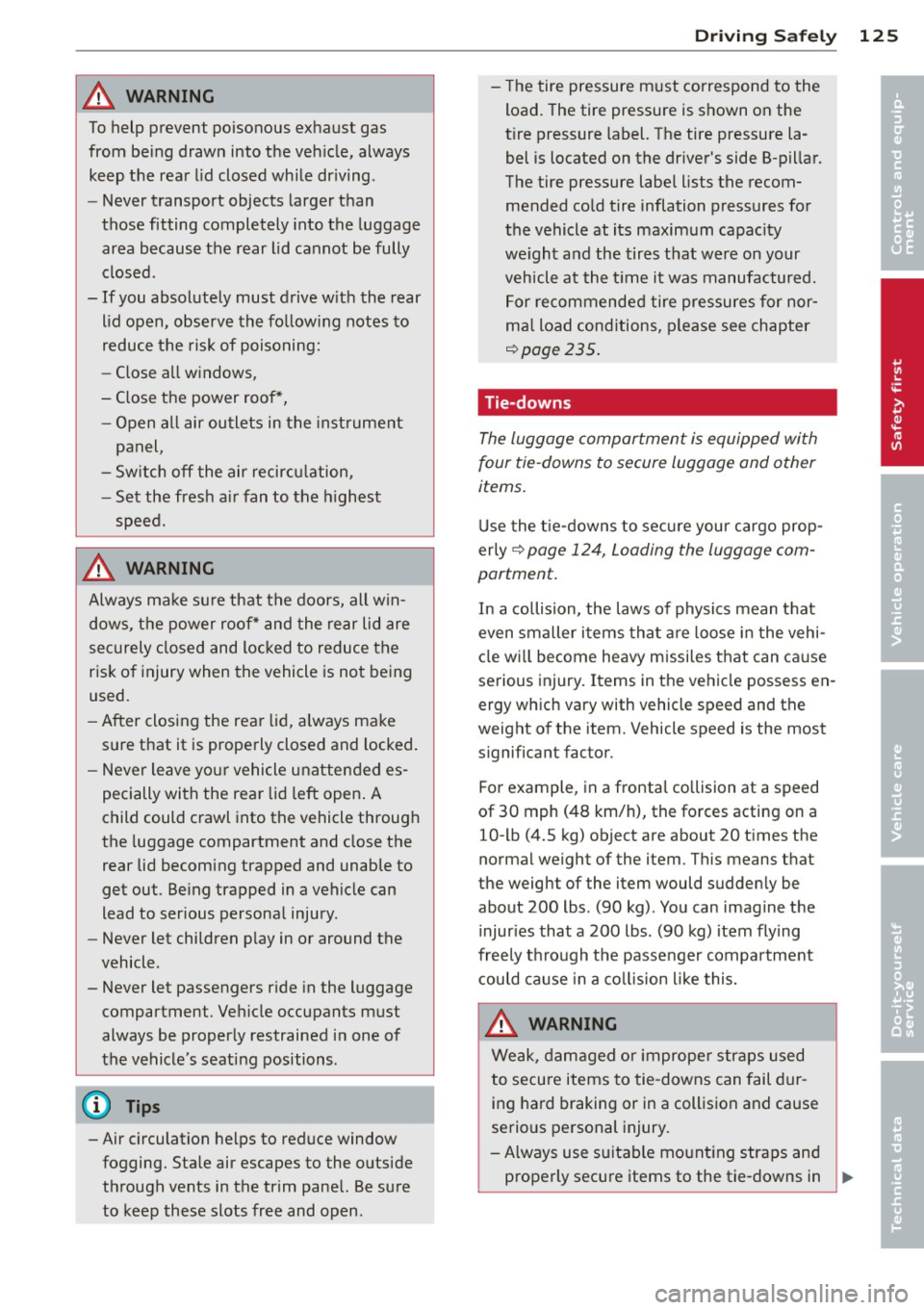
A WARNING ,~
To help prevent poisonous exhaust gas
from being drawn into the vehicle, always
keep the rear lid closed while driving .
- Never transport objects larger than
those fitting completely into the luggage
area because the rear lid cannot be fully
closed.
- If you absolutely must drive with the rear
lid open, observe the following notes to
reduce the risk of poisoning:
- Close all windows,
- Close the power roof*,
- Open all air outlets in the instrument
panel,
- Switch off the air recirculation,
- Set the fresh air fan to the highest
speed.
A WARNING
Always make sure that the doors, all win dows, the power roof* and the rear lid are
securely closed and locked to reduce the
risk of injury when the vehicle is not being
used.
- After closing the rear lid, always make
sure that it is properly closed and locked.
- Never leave your vehicle unattended es
pecially with the rear lid left open. A
child could crawl into the vehicle through
the luggage compartment and close the
rear lid becoming trapped and unable to
get out. Being trapped in a vehicle can
lead to serious personal injury.
- Never let children play in or around the
vehicle .
- Never let passengers ride in the luggage
compartment. Vehicle occupants must
always be properly restrained in one of
the vehicle's seating positions.
Gj) Tips
-Air circulation helps to reduce window fogging. Stale air escapes to the outside
through vents in the trim panel. Be sure
to keep these slots free and open .
-
Driving Safely 125
-The tire pressure must correspond to the
load. The tire pressure is shown on the
tire pressure label. The tire pressure la
bel is located on the driver's side B-pillar.
The tire pressure label lists the recom
mended cold tire inflation pressures for
the vehicle at its maximum capacity
weight and the tires that were on your
vehicle at the time it was manufactured. For recommended tire pressures for nor
mal load conditions, please see chapter
r:!)page235.
Tie-downs
The luggage compartment is equipped with
four tie-downs to secure luggage and other
items.
Use the tie-downs to secure your cargo prop
erly<>
page 124, Loading the luggage com
partment.
In a collision, the laws of physics mean that
even smaller items that are loose in the vehi
cle will become heavy missiles that can cause
serious injury. Items in the vehicle possess en
ergy which vary with vehicle speed and the
weight of the item. Vehicle speed is the most
significant factor.
For example , in a frontal collision at a speed
of 30 mph (48 km/h), the forces acting on a 10-lb (4.5 kg) object are about 20 times the
normal weight of the item. This means that
the weight of the item would suddenly be about 200 lbs. (90 kg) . You can imagine the
injuries that a 200 lbs . (90 kg) item flying
freely through the passenger compartment
could cause in a collision like this.
A WARNING
Weak, damaged or improper straps used
to secure items to tie-downs can fail dur
ing hard braking or in a collision and cause
serious personal injury.
-Always use suitable mounting straps and properly secure items to the tie-downs in
'
•
•
Page 186 of 294

184 Intelligent technology
Intelligent technology
Notice about data
recorded by vehicle
control modules
Your veh icle is not equipped with an Event Da
ta Recorde r (EDR), ins talled by some manu
facture rs fo r the express p urpose of capturing
data for retrieval after an accident or cras h
event . EDR's are sometimes ca lled "crash re
corders".
Some state laws restr ict the retr ieval or down
loading of data stored by EDR's that were in
stalled in a vehicle for the express purpose of retrieving data after an accident or crash
event without the owner's consent.
A ltho ugh yo ur vehicle is not equ ipped wit h an
EDR, it is equipped with a number of electron
ic control modules for various vehicle systems
such as, for examp le, eng ine f unction, em is
sion control, as well as for the airbags and
safety belts.
These electronic contro l modules also record
vehicle-re lated data during norma l vehicle op
erat ion for diagnostic and repa ir purposes.
The recording capacity of the electronic con
trol modules is limited to data (no sound is re
corded) and only a small amount of data is ac
tually recorded ove r a ve ry limited pe riod of
time and stored when a sys tem faul t or o ther
cond ition is sensed by a cont ro l u nit. Some of
the data then stored may re late to vehicle
speed, direction, braking as we ll as restraint
system use and performance in the event of a
crash or other condit ion. Stored data can only
be read and downloaded w ith special equip
ment.
Electronic stabilization
program (ESP)
Description
ESP helps to improve road holding and vehicle
dynamics to help reduce the probability of
skidd ing and loss of veh icle control. It works
only when the eng ine is running. ESP detects certain difficult driving situat
ions, including
when the vehicle is beginning to spin (yaw) o ut of control and helps you to get the veh icle
back under contro l by se lectively braking the
whee ls, and/or reducing engine power and
providing steer ing ass istance to he lp hold the
vehicle o n the dr ive r's intended cou rse. The in
dicato r light
G] in the instrument cluste r
blinks when ESP is taking action to help you
control the veh icle.
ESP has l imitations.
It is importa nt to remem
ber that ESP cannot overcome the laws of
physics. It will not always be able to help out
under a ll cond it ions you may come up aga inst.
F or example, ESP may not always be able to
help you master situations where there is a
s u dden change in the coefficient of friction of
the road surface. When there is a section of dry road that is sudden ly covered w ith water,
s lush or snow, ESP cannot perform the same
way it wou ld on the dry surface . If the ve hicle
hydroplanes (rides on a cushion of water in
stead of the road surface), ESP will not be
able to help you steer the vehicle be cause con
tact with the pavement has been interrupted
and the vehicle cannot be braked or steered .
D uring fast cornering, particularly on winding
roads, ESP cannot a lways deal as effectively
with difficult driv ing situations than at lower
speeds. When towing a trailer, ESP is not able
to help you regain control as it would if you
were not tow ing a trailer.
Always adjust your speed and driving style to road, traffic; and weather condit ions. ESP can
not override the vehicle's physical limits, in
crease the availab le tract ion, or keep a ve hicle
on the road if road departu re is a result of
drive r inattent io n. Instead, ESP improves the
poss ibil ity of keeping the vehi cle under con
trol and on the road during extreme maneu
vers by using the d river's steering inputs to
help keep the vehicle going in the intended di
rection . If you are traveling at a speed that
ca uses you to run off the road before ESP can
provide any assistance, you may not experi
ence the benefits of ESP .
Page 234 of 294
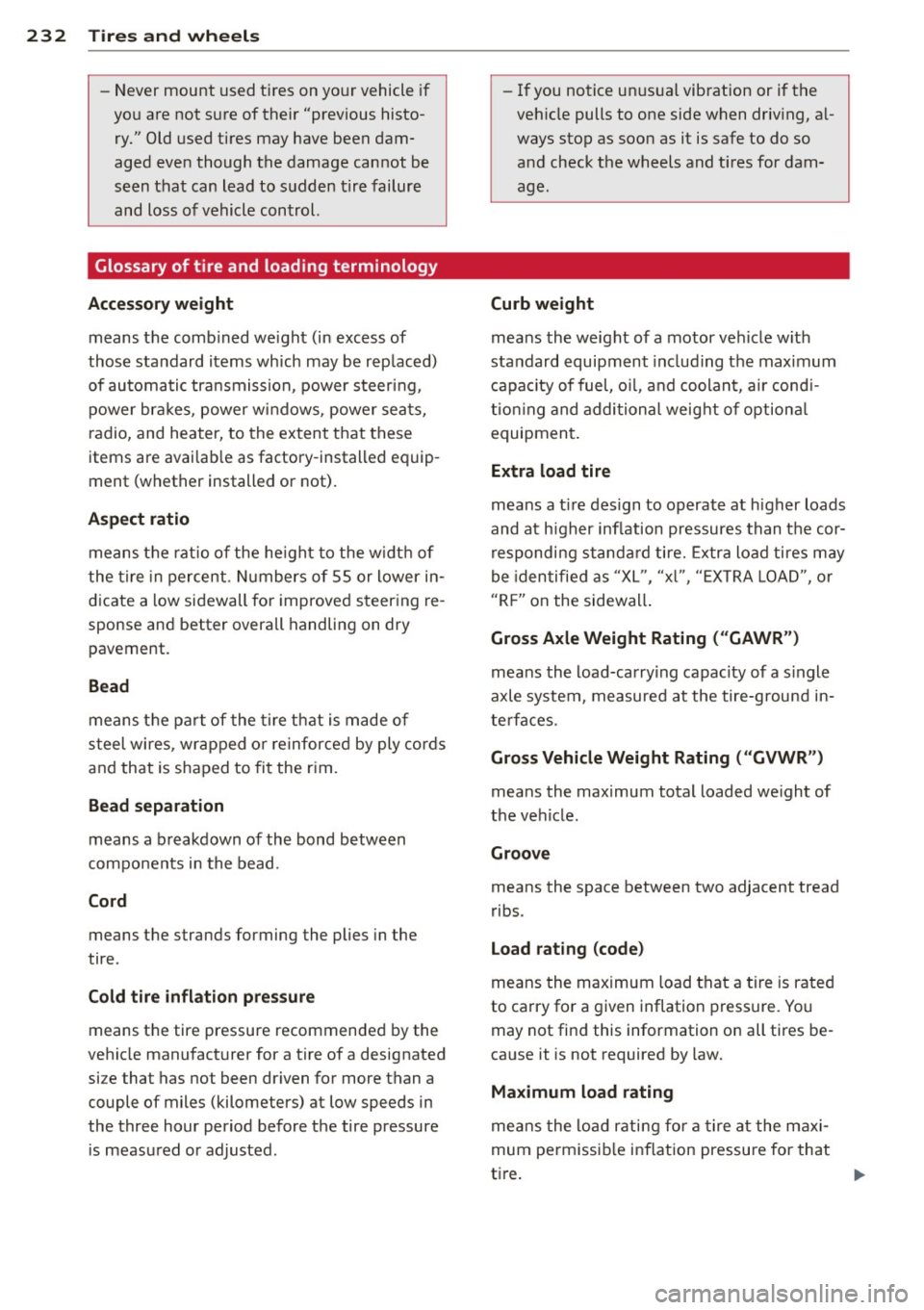
232 Tire s and wheel s
-Never mount used tires on yo ur vehicle if
you are not sure of their "previous histo
ry." Old used tires may have been dam
aged even though the damage cannot be
seen that can lead to sudden tire failure
and loss of vehicle control.
Glossary of tire and loading terminology
Accessory weight
means the comb ined we ight (in excess of
those standard items which may be rep laced)
of automa tic tra nsmission, power steer ing,
power br akes, power windows, power seats,
radio, and heater, to the extent that these
items are availab le as factory -installed equip
ment (whether installed or not) .
Aspect ratio
means the ratio of the height to the w idt h of
the tire in percent. Numbers of 55 or lower in
dicate a low sidewall fo r improved steer ing re
sponse and better overall handling on dry
pavement.
Bead
means t he pa rt of the tire that is made of
steel wires, wrapped o r reinforced by ply cords
and that is shaped to fit the r im.
Bead s eparation
means a b reakdown of the bond between
components in the bead.
Cord
means the strands forming the plies in the
tire.
Cold tire inflatio n pre ssure
means the tire pressure recommended by the
ve hicle manufacturer for a tire of a designated
size that has not been dr iven for more than a
couple of miles (kilometers) at low speeds in
the three hour period before the tire pressure i s measu red or adjusted. -
If you notice unusual vibration or if the
veh icle pulls to one side when driv ing, a l
ways stop as soon as it is safe to do so and check the wheels and tires for dam
age.
Curb weight
means the weight of a motor ve hicle w ith
standard equipment including t he maximum
capa city of fuel, o il, and coola nt, a ir cond i
tion ing and additional weig ht o f option al
equipment .
Extra load tire
means a tire design to operate at h igher loads
and at h igher inflation pressures than the cor
respondi ng standa rd tire. Extra load tires may
be identified as "X L", "xl", "EXTRA LOA D", o r
"R F" on the sidewall .
Gross Axle Weight Rating ( "GAWR ")
means the load-carrying capacity of a s ingle
axle system, measured at the tire-ground in
te rfaces .
Gross Vehicle Weight Rating ( "GVWR ")
means the maximum total loaded we ight of
t h e ve hicle.
Groove
means the space between two adjacent tread
ribs .
Load rat ing (code )
means the maximum load that a tire is rated
to carry for a given inflation press ure. Yo u
may not find this information on all tires be
ca use it is not required by law.
Maximum load rating
me ans the lo ad r ating for a tire a t the m axi
mum pe rm issib le inflation pressure for that
t ir e.
Page 235 of 294

Maximum loaded vehicle weight
means the sum of:
(a) Curb weight
(b) Accessory weight
(c) Vehicle capacity weight, and
(d) Production options weight
Maximum (permissible) inflation pressure
means the maximum cold inflation pressure
to which a tire may be inflated. Also called
"maximum inflation pressu re."
Normal occupant weight
means 150 lbs . (68 k ilograms) times the
number of occupants seated in the vehicle up
to the total seating capacity of your vehicle .
Occupant distribution
means distribution of occupants in a vehicle .
Outer diameter means the overall diameter of an inflated new
tire.
Overall width
means the linear distance between the exteri
ors of the sidewalls of an inflated tire, includ
ing e levations due to labeling, decorations, or
protective bands or ribs.
Ply
means a layer of rubber-coated para llel cords.
Production options weight
means the comb ined weight of those installed
regular production options weighing over 5
lbs . (2 .3 kg) in excess of those standard items
which they replace, not previously considered
in curb weight or accessory weight, including
heavy duty brakes, r ide leve lers, roof rack,
heavy duty battery, and specia l trim .
Radial ply tire
means a pneumatic t ire in which the p ly cords
that extend to the beads are laid at substan
tially 90 degrees to the centerline of the
tread.
Tires and wheels 233
Recommended inflation pressure
see~
page 232, Cold tire inflation pressure.
Reinforced tire
means a t ire design to operate at higher loads
and at higher inflation pressures than the cor
responding standard tire. Reinforced tires
may be identified as "XL" , "x l", " EXTRA LOAD",
o r "R F" on the sidewall.
Rim
means a metal support for a tire or a t ire and
tube assembly upon which the tire beads are
seated.
Rim diameter
means nom inal d iameter of the bead seat. If
you change your wheel s ize, you w ill have to
purchase new tires to match the new r im di
ameter.
Rim size designation
means r im diameter and width.
Rim width
means nom inal distance between rim fla nges.
Sidewall
means that portion of a tire between the
tread and bead.
Speed rating (letter code)
means the speed at which a tire is designed to
be driven for extended periods of time. The
ratings range from 93 mph (150 km/h) to
186 mph (298 km/h)
~ page 243 . You may
not find this information on all tires because
it is not requ ired by law.
The speed rating letter code, where applica
ble, is molded on the tire sidewall and indi
cates the max imum pe rm issib le road speeds
~ .&. in Winter tires on page 247 .
Tire pressure monitoring system*
means a system that detects when one or
more of a veh icle's tires are underinflated and
illuminates a low tire pressure warning tell
tale.
•
•
Page 236 of 294
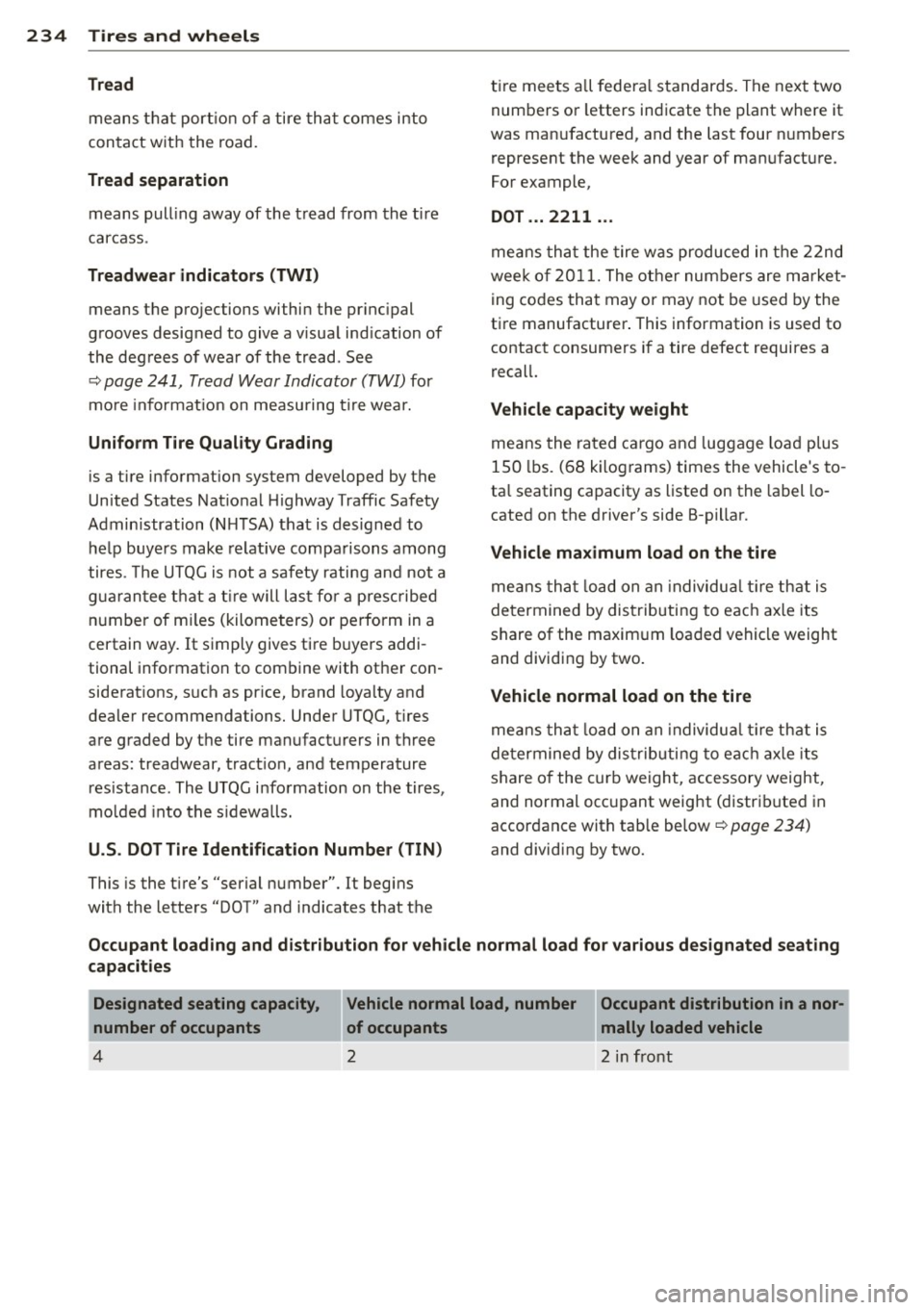
234 Tires and wheels
Tread
means that portion of a tire that comes into
contact with the road.
Tread separation
means pull ing away of the tread from the tire
carcass .
Treadwear indicators (TWI)
means the projections within the principal
grooves designed to give a visual ind ication of
the degrees of wear of the tread . See
~ page 241, Tread Wear Indicator (TWI) for
more informat ion on measuring tire wear.
Uniform Tire Quality Grading
is a tire information system developed by the
United States Nat ional Highway Traffic Safety
Administration (NH TSA) that is designed to
help buyers make relative comparisons among
tires. The UTQG is not a safety rating and not a
guarantee that a tir e will last fo r a prescribed
number of miles (kilometers) or perform in a
certain way. It simply gives tire buyers addi
tional information to combine with other con
siderat ions, such as price, brand loyalty and
dealer recommendations. Under UTQG, tires
are graded by the tire manufacturers in three
areas: treadwear, tract ion, and temperature
res istance. The UTQG information on the tires,
mo lded into the sidewalls.
U.S. DOT Tire Identification Number (TIN)
This is the tire's "serial number". It begins
with the letters "DOT" and indicates that the ti
re meets a ll federal standards. The next two
numbers or letters indicate the plant where it
was manufactured, and the last four numbers
represent the week and year of manufacture.
For example,
DOT . .. 2211 ...
means that the tire was produced in the 22nd
week of 2011. The other numbers are market
ing codes that may or may not be used by the
tire manufacturer . This information is used to
contact consumers if a tire defect requires a
recall.
Vehicle capacity weight
means the rated cargo and luggage load plus
150 lbs. (68 kilograms) times the vehicle's to
ta l seating capacity as listed on the label lo
cated on the driver's side B-pillar.
Vehicle maximum load on the tire
means that load on an individua l tire that is
determined by distributing to each axle its
share of the maximum loaded vehicle weight
and dividing by two.
Vehicle normal load on the tire
means that load on an individua l tire that is
determined by distributing to eac h axle its
share of the curb weight , accessory weight,
and normal occupant weight (distributed in
accordance with tab le below ~
page 234)
and dividing by two.
Occupant loading and distribution for vehicle normal load for various designated seating
capacities
Designated seating capacity,
number of occupants
4
Vehicle normal load, number Occupant distribution in a nor-
of occupants _____ malty loaded vehicle
2 2 in front
Page 238 of 294
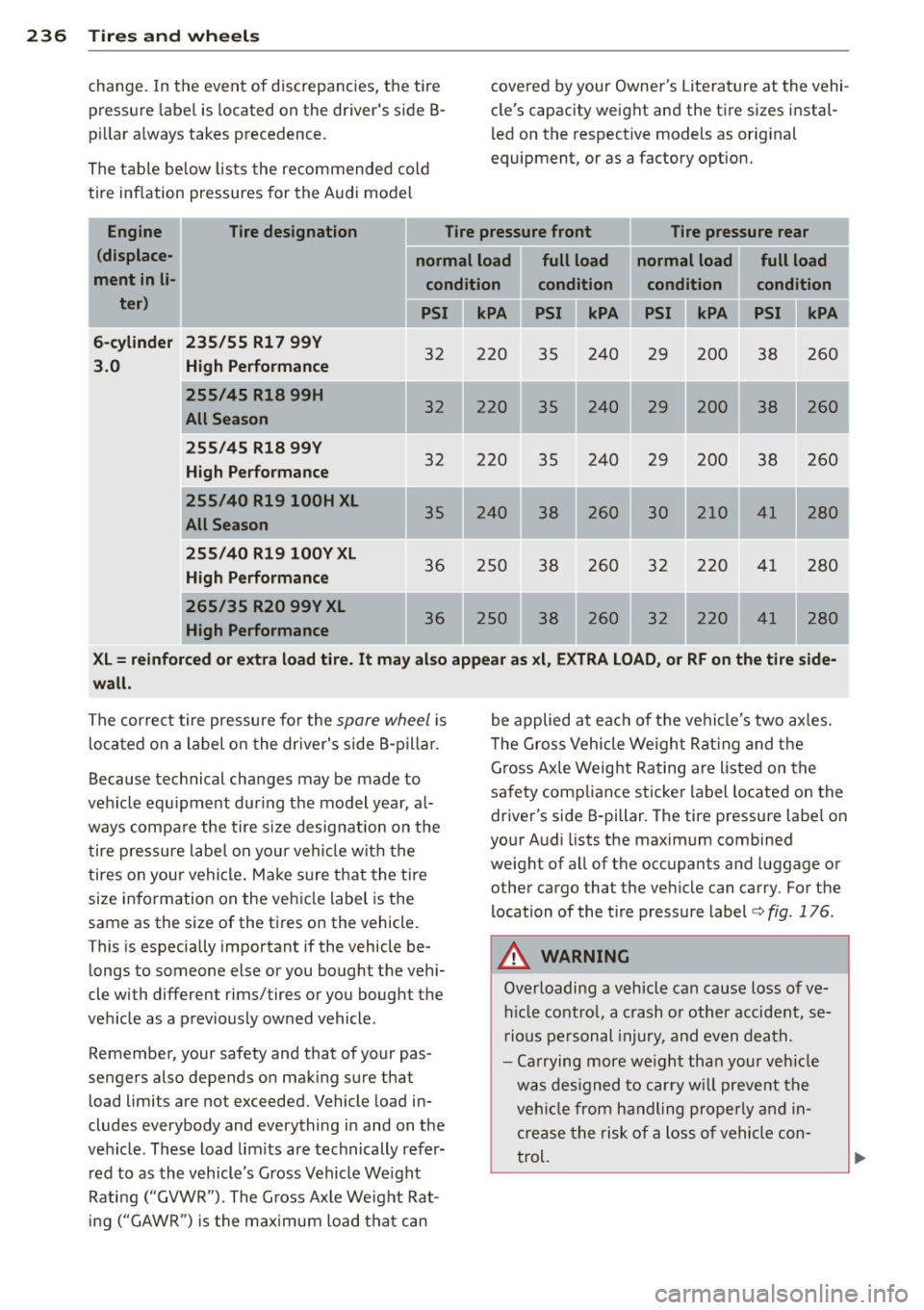
236 Tires and wheels
change. In the event of discrepancies, the tire
pressure labe l is located on the driver's side B
p ill ar a lways takes precedence.
The table below lis ts the recommended cold
tire inflation pressures for the Audi model covered
by your Owner's Literature at the vehi
cle's capacity weight and the tire sizes instal
l ed on the respective models as orig inal
equipment, or as a factory option.
I Engine Tire designation
Tire pressure front Tire pressure rear I
(displace-
normal load full load normal load full load
ment in
li-condition condition condition condition
I
ter) PSI II kPA PSI JI kPA PSI II kPA PSI II kPA :
6-cylinder 235/55
Rl 7 99Y
3.0 High Performance 32
220
35 240 29 200
38 260
255/45 Rl8 99H '
32 220 35
240
29 200 38 260 All Season I
255/45 Rl8 99Y
32 220 35 240 29 200 38 260
High Performance
255/40 Rl9100H XL
35 240
38 260
30 2 10 41
280 All Season
255/40
Rl9100YXL
36 250 38 260 32 220 41 280
High Performance
265/35 R20 99Y XL '
36 250 38 260 32 220 41 280
High Performance .. • .. .. .. .. ..
XL= reinforced or extra load tire. It may also appear as xl, EXTRA LOAD, or RF on the tire side
wall.
The correct tire pressure for the spore wheel is
loc ated on a label on the driver's side B-pillar.
Because technical changes may be made to
vehicle equ ipment dur ing the model year, a l
ways compare the tire size designation on the
tire pressure labe l on your vehicle w ith the
tires on your vehicle . Make sure that the tire
size information on the vehicle label is the
same as the size of the ti res on the vehicle.
This is especially important if the vehicle be
longs to someone else or you bought the vehi
cle with different rims/tires or you bought the
vehicle as a previously owned vehicle.
Remember, your safety and that of your pas
sengers also depends on making sure that load limits are not exceeded. Vehicle load in
cludes everybody and everything in and on the
vehicle . These load limits are technically refer
red to as the vehicle's Gross Vehicle We ight
Rating ("GVWR"). The Gross Ax le Weight Rat
ing ("GAWR") is the maximum load that can be applied at each
of the vehicle's two ax les .
T he Gross Vehicle Weight Rat ing and the
Gross Axle Weight Rating are listed on the
safety compliance sticke r label located on the
driver's side B-pillar. The tire pressure labe l on
your Audi lists the maximum combined
weight of all of the occupants and luggage or
other cargo that the vehicle can carry . For the
location of the tire pressure label
¢fig. 176 .
A WARNING
-Overloading a vehicle can cause loss of ve-
hicle control, a crash or other accident, se
r ious personal injury, and even death.
- Carrying more weight than your veh icle
was designed to carry will prevent the
vehicle from handling properly and in
crease the risk of a loss of vehicle con
trol.
Page 239 of 294
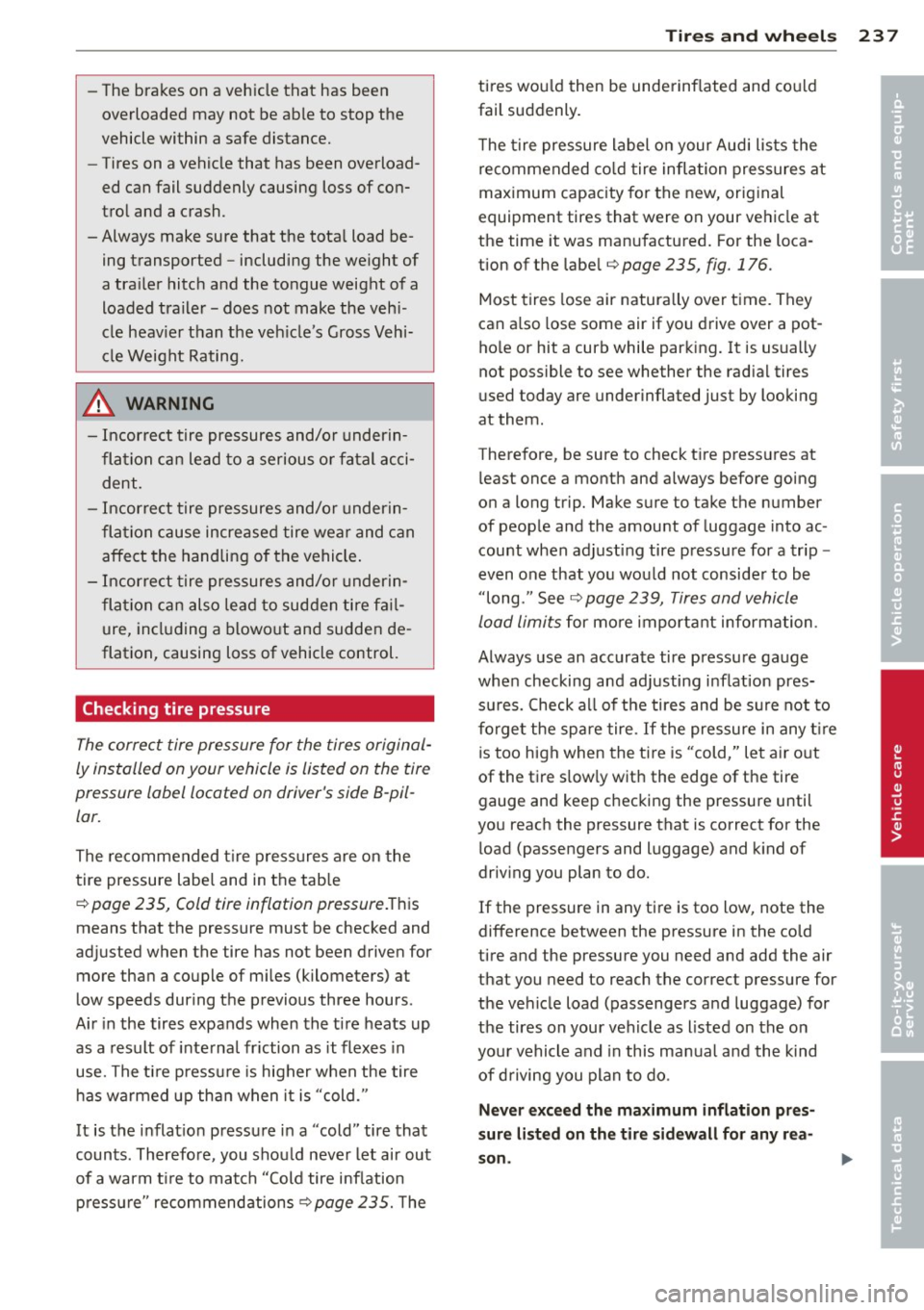
-The brakes o n a vehicle t hat has been
overloaded may not be a ble to stop the
vehicle within a safe distance.
- Tires on a vehicle that has been overload
ed can fail suddenly causing loss of con
trol and a crash.
- Always make sure that the tota l load be
ing transported -including the we ight of
a tra ile r hitch and the tongue weight of a
loaded trailer - does not make the veh i
cle heav ier than the veh icle's Gross Vehi
cl e Weight Rating.
A WARNING
- Incorrect tire pressures and/or underin
fla tion can lead to a serious o r fatal acci
dent.
- Incorrect tire pressures and/or underin
fla tion cause increased tire wea r and can
affect the handling of the vehicle .
- Incorrect tire pressures and/or underin
flation can also lea d to sud den tire fa il
ure, incl uding a blowo ut and sudden de
flation, causing loss of vehicle control.
Checking tire pressure
.
The correct tire pressure for the tires original
ly installed on your vehicle is listed on the tire
pressure Lobel located on driver's side 8-pil lor.
The re commended t ire press ures a re o n the
tire pressure label and in the tab le
c=> page 235, Cold tire inflation pressure. This
means that the pressure must be checked and
adj usted when the tire has not been driven for
more than a couple of m iles (kilometers) at
low speeds during the previous three hours .
A ir i n the tires expands when the tire heats up
as a result of inte rnal fr iction as it flexes in
use. The t ire p ress ure is higher w hen the tire
h as wa rmed up th an when it is "cold."
It is the inflat io n pressu re in a "cold" tire that
counts. Therefore, you shou ld never let air out
of a warm t ire to ma tch "Cold tire in flation
p ressu re" recommend ations
c::> page 235. T he
Tire s an d wheel s 237
tires wo uld then be unde rinflated and co uld
fail suddenly.
T he tire pressure label on your Aud i lis ts the
re commended co ld tire inflation pressures at
maximum capacity for the new, orig inal
equipment tires that were on your ve hicle at
the time it was manufactured. For the loca
tion of the labe l
c::> page 235, fig. 176.
Most tires lose air naturally over t ime. They
can a lso lose some air if yo u drive over a pot
ho le or hit a curb while par king. It is usually
not possible to see whether the rad ia l tires
u sed today are underinflated just by looking
at them .
There fore, be sure to check t ire p ress ures at
l east once a month and always before going
on a long tr ip. Make sure to take the n umber
of peop le and the amount of luggage into ac
count when adjust ing tire pressure for a tr ip -
even one that you wou ld not conside r to be
"long." See
c::> page 239, Tires and vehicle
food limits
f or mo re import ant inform ation .
Always use an accurate ti re pressu re gauge
when checking and ad justing inflation pres
s ur es. Check a ll of t he tires and be s ure not to
forge t the spare tire.
If the pressure in any t ire
is too high when the ti re is "cold," let air out
of the ti re s low ly with the edge of the tire
gauge and keep checking the pressure until
you reach the pressure that is correct for the
load (passengers and luggage) and k ind of
driv ing you plan to do.
If the pressure in any ti re is too low, note the
difference between the pressure in the co ld
tire and the pressure you need and add the air
that you need to reach the correct pressure for
the ve hicle load (passengers and luggage) for
the tires on you r veh icle as listed on the on
you r vehicle and in this ma nual and the kind
of d rivi ng you plan to do .
Never exceed th e maximum inflation pr es
sure listed on the tire sidewall for any rea
s on.
•
•
Page 241 of 294
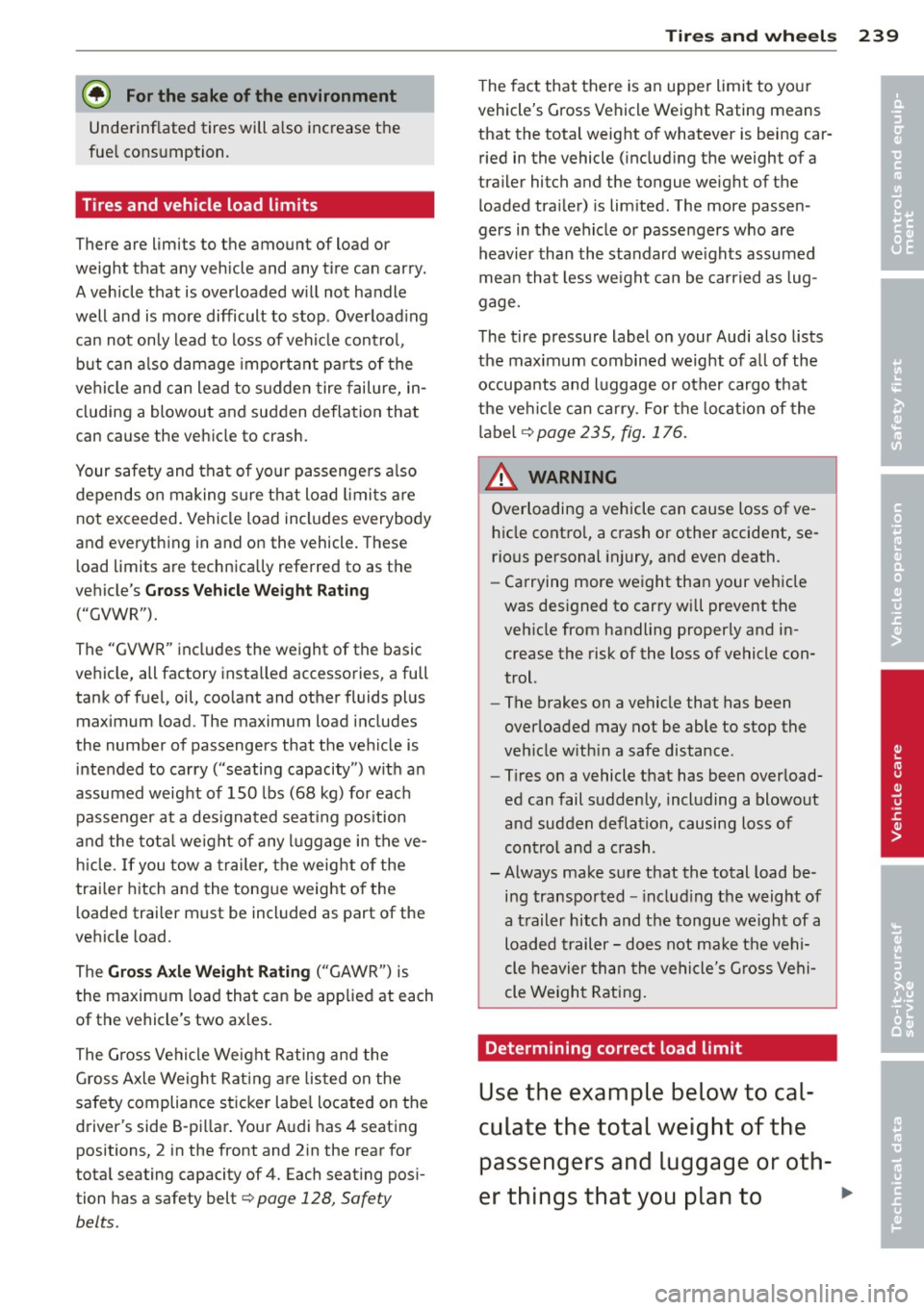
@ For the sake of the environment
Underinflated tires will a lso increase the
fue l consumption .
Tires and vehicle load limits
There are limits to the amount of load or
weight that any vehicle and any t ire can carry.
A vehicle that is overloaded w ill not handle
well and is more difficult to stop. Overload ing
can not only lead to loss of vehicle control, but can a lso damage importan t pa rts of the
ve hicle and can lead to s udden tire failure, in
cluding a blowout and sudden deflation that
can cause the veh icle to crash.
Your safety and that of yo ur passenge rs a lso
depends on making s ure that load limits are
not exceeded . Vehicle load includes everybody
and everything in and on the vehicle. These
load limits are technica lly referred to as the
vehicle's
Gross Veh icle We ight R ating
("GVWR").
The "GVWR" includes the weight of the basic
vehicle, all factory insta lled accessories, a full
tank of f ue l, oil, coolant and other fluids plus
maximum load. The maximum load includes
the number of passengers that the vehicle is intended to carry ("seating capacity") with an
assumed weight of 150 lbs (68 kg) for each
passenger at a des ignated seat ing pos ition
and the total we ight of any l uggage in the ve
hi cle. If you tow a trailer, the weight of the
trailer hitch and the tong ue weight of the
loaded trailer must be included as part of the
vehicle load.
The
Gro ss Axl e W eight R ating ("GAWR") is
the maximum load that can be app lied at each
of the vehicle's two axles.
The Gross Vehicle Weight Rating and the
Gross Axle Weight Rating a re listed on the
safety compliance sticker labe l located on the
driver's side B -pillar . Your A udi has 4 seating
positions, 2 in the front and 2 in the rear for
total seating capacity of 4. Each seating pos i
tion has a safety belt¢
page 128, Safety
belts .
Tire s an d wheel s 239
The fact that there is an upper limit to your
vehicle's Gross Vehicle Weight Rating means
that the total weight of whatever is being car
ried in the vehicle ( includ ing the weight of a
trailer hitch and the tongue weight of the
loaded tra iler) is lim ited. The more passen
gers in the vehicle or passengers w ho are
heavier than the standard we ights assumed
mean that less we ight can be ca rried as lug
gage.
The tire pressure label on your Aud i also lists
the maximum combined weight of a ll of the
occupants and luggage or other cargo that
the ve hicl e can carry . For t he locat ion of the
label¢
page 235, fig . 176.
.&_ WARNING ~
Overloading a vehicle can cause loss of ve -
h icle contro l, a crash or other accident, se
rious personal injury, and even death.
- Carrying more weight than your vehicle
was designed to carry wi ll prevent the
veh icle from handling properly and in
crease the risk of the loss of vehicle con
trol.
- The brakes on a vehicle that has been
overloaded may not be able to stop the
veh icle w ith in a safe distance.
- Tires on a vehicle that has been over load
ed can fail suddenly, including a blowout
and sudden deflation, causing loss of
control and a crash .
- Always make sure that the total load be
ing transported -includ ing the weight of
a t railer hitch and the tongue we ight of a
loaded trailer - does not ma ke t he vehi
cle heavier than the vehicle's G ross Vehi
cle Weight Rating.
Determining correct load limit
U se th e exa mple below to cal
c ulat e the total weight of the
pa ssen ger s a nd lu ggag e or ot h-
e r thin gs that you pl an t o .,..
•
•